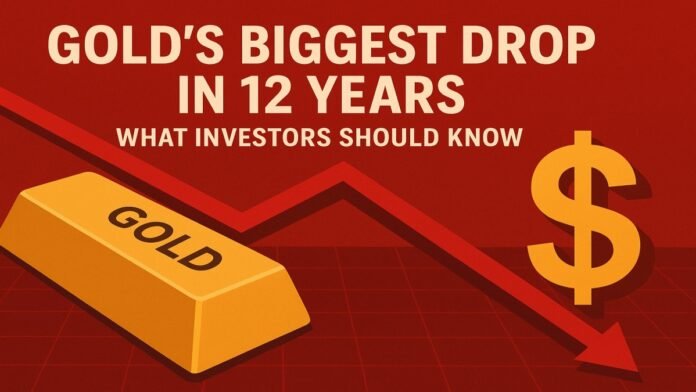
Key Points
- Gold on the Multi Commodity Exchange plummeted ₹7,369 per 10 grams from ₹1,30,624 on October 20 to ₹1,23,255 by October 24, marking the sharpest weekly decline since May 2025 and ending a remarkable nine-week rally that pushed prices to all-time highs.
- International spot gold prices fell 5.7% on October 21, the steepest single-day decline in 12 years after touching a record $4,381.21 per ounce on October 20, with the precious metal dropping over 6% from its peak as investors unwound positions built during the year’s 56% rally.
- The correction was triggered by massive profit-booking following stretched valuations, with gold-backed ETFs experiencing their largest single-day outflow in five months on October 22, signaling institutional investors reducing exposure after consecutive record highs during the festival buying period.
- Improving US-China trade relations, with President Donald Trump scheduled to meet Chinese President Xi Jinping in late October, reduced geopolitical anxiety and safe-haven demand, while a strengthening US dollar made gold more expensive for international buyers.
- Despite the sharp pullback, major investment banks maintain bullish long-term outlooks, with JP Morgan forecasting gold to average $5,055 per ounce by Q4 2026 and maintaining a $6,000 target by 2028, describing the current decline as a “healthy consolidation” after rapid gains.
New Delhi: India’s gold market witnessed a dramatic reversal in fortunes during the final week of October 2025, as prices that had been soaring to unprecedented heights during the Dhanteras-Diwali festival period crashed spectacularly, erasing gains worth thousands of rupees in a matter of days. The sudden correction ended a remarkable nine-week winning streak that had transformed gold into one of 2025’s best-performing assets, leaving investors grappling with the precious metal’s steepest decline in over a decade.
On the Multi Commodity Exchange, gold futures with December 5 expiry plunged from ₹1,30,624 per 10 grams on Monday, October 20, to ₹1,23,255 by Friday, October 24, a staggering decline of ₹7,369 in just four trading sessions. As of October 26, MCX gold stabilized around ₹1,23,451 per 10 grams, while domestic spot prices across major Indian cities settled at ₹1,25,620 for 24-carat gold, ₹1,15,150 for 22-carat, and ₹94,220 for 18-carat gold.
The domestic market correction mirrored an even more dramatic collapse in international bullion markets, where gold suffered its worst single-day loss since 2013. Spot gold plummeted 5.7% on October 21 to $4,143 per ounce, the largest one-day decline in 12 years after touching a record of $4,381.21 per ounce just one day earlier. By Friday, October 24, international gold prices stabilized around $4,118.68 per ounce, down approximately 6% from Monday’s peak and posting a weekly decline of 3.3% the sharpest weekly drop since mid-May.
Anatomy of the Collapse: From Record Highs to Sharp Correction
The velocity and magnitude of gold’s reversal caught many market participants off guard, particularly given the precious metal’s extraordinary performance throughout 2025. Gold had rallied an astonishing 56% year-to-date through October 21, driven by a confluence of factors including persistent inflation fears, geopolitical tensions, aggressive central bank purchasing, and anticipation of US Federal Reserve interest rate cuts.
In India specifically, the festival buying period surrounding Dhanteras (October 18) and Diwali amplified demand to exceptional levels, with 22-carat gold touching a record high of ₹1,41,000 per 10 grams on Dhanteras before the subsequent correction. According to data from the Indian Bullion and Jewellers Association, 24-carat gold opened at ₹1,26,730 per 10 grams on Monday, October 20, and briefly rose to ₹1,27,633 before beginning its descent. By Friday evening, prices had tumbled to ₹1,21,518, a reduction of ₹6,115 per 10 grams in the domestic spot market.
Profit-Booking Tsunami and ETF Exodus
The most immediate catalyst for the correction was massive profit-taking by investors who had accumulated positions during gold’s parabolic ascent. Tim Waterer, Chief Market Analyst at KCM Trade, noted that a sharp jump in volatility at the highs over the past week flashed caution signals and encouraged at least short-term profit-taking.
Institutional investors joined retail participants in unwinding positions, as evidenced by dramatic outflows from gold-backed exchange-traded funds. The single-day outflow from gold-backed ETFs on October 22 represented the largest exodus in five months, according to Bloomberg data. Global gold ETFs recorded net outflows in mid-October after a surge of inflows during September, with the redemptions signaling short-term profit-taking and reducing institutional demand for bullion.
Market watchers characterized many recent gold buyers as “gold tourists,” short-term investors who piled in on fear of missing out and were subsequently forced to sell when prices turned lower. This cohort of speculative participants amplified both the upward momentum during the rally and the downward pressure during the correction.
Easing Geopolitical Tensions and Dollar Strength
Beyond technical factors and profit-booking, fundamental shifts in the global economic and political landscape contributed significantly to gold’s retreat. The precious metal thrives during periods of heightened uncertainty, functioning as a safe-haven asset when geopolitical tensions, trade conflicts, inflation concerns, and policy uncertainty create anxiety among investors.
However, signs emerged in late October that some of these fears were beginning to fade. Most significantly, renewed optimism about potential de-escalation in US-China trade tensions, which had intensified throughout 2025 with reciprocal tariff actions, began to reduce safe-haven demand for gold.
According to Reuters reporting, the White House confirmed that US President Donald Trump was scheduled to meet with Chinese President Xi Jinping during his Asia trip in late October, raising hopes for a diplomatic breakthrough that could ease the trade war that has dragged on global growth. Tim Waterer explained that a meeting between the US and Chinese leaders stands a decent chance of de-escalating trade tensions, which is aiding the dollar and drying up some safe-haven demand for gold.
The strengthening US dollar added additional pressure on gold prices. The Bloomberg Dollar Spot Index gained for three consecutive sessions through October 24, rising approximately 0.4% and making gold more expensive for investors holding other currencies. Because gold is priced in dollars globally, when the US currency strengthens, it tends to make the precious metal more expensive for non-US investors, naturally dampening international demand.
MCX gold faced immediate resistance at ₹1,24,050, followed by ₹1,24,650, where sustained buying could revive bullish momentum, while support levels were identified at ₹1,23,000, with further downside risk to ₹1,22,500 if selling pressure intensified. On the international front, the critical technical level to watch was the $4,192 pivot point, with major support at the psychological $4,000 threshold.
Current Price Landscape Across Indian Cities
As of October 26, 2025, gold prices in India had stabilized following the week’s dramatic volatility, though they remained significantly below the Dhanteras-Diwali peaks. According to data aggregated from Goodreturns and various bullion associations, 24-carat gold traded at ₹1,25,620 per 10 grams, 22-carat at ₹1,15,150, and 18-carat at ₹94,220, representing a decline of nearly ₹7,150 per 100 grams for 24-carat gold since October 17.
In Mumbai, India’s financial capital and a major bullion trading hub, prices stood at ₹1,25,620 per 10 grams for 24-carat gold, ₹1,15,150 for 22-carat, and ₹94,220 for 18-carat as of Sunday morning. Delhi recorded marginally higher rates at ₹1,25,770 per gram for 24-carat gold, while Chennai, Kolkata, and Bangalore mirrored Mumbai’s pricing structure.
Silver prices experienced an even sharper correction percentage-wise, with domestic rates stabilizing at ₹1,55,000 per kilogram on October 26, down from highs exceeding ₹1,70,000 earlier in the month. MCX silver with December 2025 expiry nosedived by ₹2,732 on October 24 alone, hitting an intraday low of ₹1,45,780 per kilogram before recovering marginally to ₹1,46,397, a decline of ₹2,115 or 1.42%.
It’s important to note that retail consumers purchasing gold jewelry pay additional costs beyond the base bullion rates published by exchanges and associations. A 3% Goods and Services Tax applies to all gold purchases in India, and jewelers charge making charges that vary significantly across different cities, designs, and establishments, typically ranging from ₹300 to ₹1,000 per gram depending on the complexity of the piece.
Economic Data and Federal Reserve Policy in Focus
As gold prices stabilized following the week’s dramatic selloff, market participants turned their attention to key economic data releases and central bank policy decisions that could determine the precious metal’s near-term trajectory. The US Consumer Price Index report for September, which had been delayed due to a government shutdown, was released on October 24 and showed core inflation holding steady at 3.1% in line with market expectations.
The inflation data assumed heightened significance because it would inform the Federal Reserve’s interest rate decision at its upcoming October 29 meeting. Markets had nearly priced in a 25-basis-point rate cut, which would mark the Fed’s continued pivot toward monetary easing after initiating cuts in September. Tim Waterer noted that from gold’s perspective, a tame CPI print would be welcomed as this would keep the Fed on track to cut rates twice before year-end.
Long-Term Bullish Outlook Despite Near-Term Volatility
Despite the sharp correction that erased thousands of rupees from gold prices in a matter of days, major investment banks and market strategists maintain constructive long-term outlooks for the precious metal. JP Morgan analysts on October 23 reaffirmed their bullish stance, forecasting that gold will average $5,055 per ounce by the fourth quarter of 2026 and maintaining a longer-term target of $6,000 per ounce by 2028.
Other major financial institutions have similarly raised their gold price forecasts in recent weeks. HSBC increased its 2025 average gold price forecast on October 17 by $100 to $3,455 per ounce, citing geopolitical tensions, economic uncertainty, and a weakening US dollar as driving forces, while projecting prices could reach $5,000 in 2026. Goldman Sachs raised its December 2026 projection from $4,300 to $4,900 per ounce in early October, pointing to persistent global uncertainty and central bank purchases as primary catalysts.
Structural Drivers Remain Intact
Central banks globally, particularly in emerging markets, have been accumulating gold reserves at historically elevated rates throughout 2025. India, China, Germany, and numerous other nations have significantly increased their gold holdings as part of a broader portfolio diversification strategy aimed at reducing dependence on US dollar-denominated assets. This official sector demand provides a structural floor under prices that is largely independent of short-term speculative flows.
The so-called “debasement trade” continues to attract investors concerned about expanding government deficits, rising sovereign debt levels, and the potential erosion of fiat currency purchasing power. JP Morgan analysts noted that the rally is not purely a de-dollarization or debasement story, but rather represents a dollar diversification story, with foreign investors gradually reallocating small portions of their US asset holdings into gold.
Additionally, ongoing geopolitical uncertainties, including the Russia-Ukraine conflict, tensions in the Middle East, US-China strategic competition, and upcoming elections in major economies, continue to support safe-haven demand. Any escalation in US-Russia tensions or sanctions, or setbacks in US-China trade negotiations, could quickly reverse the recent price weakness and propel gold toward new highs.
Investment Strategies Amid Volatility
For individual investors navigating the current market volatility, financial advisors offer nuanced guidance that balances short-term caution with long-term conviction. The sharp correction has created what some strategists view as an attractive entry point for those who missed the earlier rally or wish to add to existing positions.
Gold exchange-traded funds offer an accessible, low-cost, and liquid vehicle for gaining exposure to precious metals without the storage, insurance, and security concerns associated with physical ownership. Unlike coins or bars, ETFs can be bought and sold instantly during market hours, allowing investors to react swiftly to price movements while benefiting from minimal management costs. Major gold ETFs track spot prices closely, providing nearly identical returns to holding physical bullion itself.
However, investors are advised to monitor several key factors before making allocation decisions. The upcoming Federal Reserve meeting on October 29 could provide important guidance on the trajectory of US interest rates, which significantly influence gold’s attractiveness relative to yield-bearing alternatives. The trajectory of US-China trade negotiations, particularly following the anticipated Trump-Xi meeting, will impact safe-haven demand dynamics.
Additionally, gold price movements in the near term will be influenced by the strength of the US dollar, global inflation trends, geopolitical developments, and the pace of central bank accumulation. Buyers are advised to monitor gold prices closely and invest when rates are relatively lower, taking advantage of technical pullbacks to build positions for longer-term appreciation.
For those focused on physical gold purchases for weddings, festivals, or cultural occasions, the current price levels represent a significant discount compared to the Dhanteras-Diwali period just days earlier. The ₹7,000+ decline per 10 grams effectively reverses the premium that developed during peak festival buying, potentially making current levels attractive for those with near-term jewelry needs.
Market Outlook: Consolidation or Further Decline?
As October 2025 draws to a close, gold market participants remain divided on whether the current pullback represents a temporary consolidation before the next leg higher, or the beginning of a more sustained correction after an overextended rally. Technical analysts note that gold’s ability to hold above the psychologically important $4,000 per ounce level internationally, and ₹1,23,000 per 10 grams on MCX, suggests the structural bull market remains intact despite the sharp near-term decline.
Overall, the consensus among market experts frames the recent decline as a consolidation phase rather than a market capitulation, providing a pause after a sustained nine-week rally. The precious metal has remained up approximately 49-50% year-to-date as of late October, an extraordinary return by any measure that validates gold’s status as one of 2025’s top-performing assets, despite the recent pullback.
The coming weeks will prove critical in determining whether gold can stabilize around current levels and resume its upward trajectory, or whether additional technical selling pressure will test lower support zones. With the Federal Reserve meeting, ongoing US-China negotiations, central bank policy decisions, and year-end portfolio rebalancing all on the horizon, volatility is likely to remain elevated as 2025 draws to a close.

















































